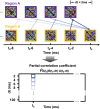Neural dynamics of semantic composition
- PMID: 31570590
- PMCID: PMC6800340
- DOI: 10.1073/pnas.1903402116
Neural dynamics of semantic composition
Abstract
Human speech comprehension is remarkable for its immediacy and rapidity. The listener interprets an incrementally delivered auditory input, millisecond by millisecond as it is heard, in terms of complex multilevel representations of relevant linguistic and nonlinguistic knowledge. Central to this process are the neural computations involved in semantic combination, whereby the meanings of words are combined into more complex representations, as in the combination of a verb and its following direct object (DO) noun (e.g., "eat the apple"). These combinatorial processes form the backbone for incremental interpretation, enabling listeners to integrate the meaning of each word as it is heard into their dynamic interpretation of the current utterance. Focusing on the verb-DO noun relationship in simple spoken sentences, we applied multivariate pattern analysis and computational semantic modeling to source-localized electro/magnetoencephalographic data to map out the specific representational constraints that are constructed as each word is heard, and to determine how these constraints guide the interpretation of subsequent words in the utterance. Comparing context-independent semantic models of the DO noun with contextually constrained noun models reflecting the semantic properties of the preceding verb, we found that only the contextually constrained model showed a significant fit to the brain data. Pattern-based measures of directed connectivity across the left hemisphere language network revealed a continuous information flow among temporal, inferior frontal, and inferior parietal regions, underpinning the verb's modification of the DO noun's activated semantics. These results provide a plausible neural substrate for seamless real-time incremental interpretation on the observed millisecond time scales.
Keywords: EEG/MEG; RSA; computational modelling; directed connectivity; speech.
Copyright © 2019 the Author(s). Published by PNAS.
Conflict of interest statement
The authors declare no competing interest.
Figures








References
-
- Moss H. E., Marslen-Wilson W. D., Access to word meanings during spoken language comprehension: Effects of sentential semantic context. J. Exp. Psychol. Learn. Mem. Cogn. 19, 1254–1276 (1993). - PubMed
-
- Johnson-Laird P. N., The mental representation of the meaning of words. Cognition 25, 189–211 (1987). - PubMed
-
- Hagoort P., On Broca, brain, and binding: A new framework. Trends Cogn. Sci. 9, 416–423 (2005). - PubMed
-
- Baggio G., Hagoort P., The balance between memory and unification in semantics: A dynamic account of the N400. Lang. Cogn. Process. 26, 1338–1367 (2011).
-
- Hagoort P., Baggio G., Willems R. M., “Semantic unification” in The Cognitive Neurosciences, Gazzaniga M. S., Ed. (MIT Press, ed. 4, 2009), pp. 819–836.
Publication types
MeSH terms
LinkOut - more resources
Full Text Sources

